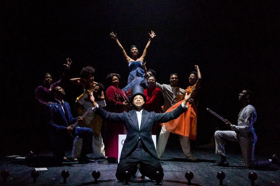Review: THE BLACK CLOWN World Premiere at A.R.T.

The Black Clown
Adapted from Langston Hughes' poem by Davóne Tines & Michael Schachter; Music by Michael Schachter; Scenic & Costume Design, Carlos Soto; Lighting Design, John Torres; Sound Design, Kai Harada; Orchestrations & Arrangements, Michael Schachter; Additional Arrangements for the A.R.T. premiere, Jaret Landon; Hair and Wig Design, Rachel Padula-Shufelt; Production Stage Manager, Taylor Brennan; Music Director, Jaret Landon; Choreography, Chanel DaSilva; Directed by Zack Winokur
CAST: Davóne Tines, The Black Clown; Ensemble: Sumayya Ali, Malcolm Armwood, Daniel Bellomy, Dawn Bless, LaVon Fisher-Wilson, Lindsey Hailes, Evan Tyrone Martin, Jhardon DiShon Milton, Brandon Michael Nase, Amber Pickens, Jamar Williams, Hailee Kaleem Wright; Swings, Emmanuel Henreid, Ashley LaLonde
Performances through September 23 at American Repertory Theater, Loeb Drama Center, 64 Brattle Street, Cambridge, MA; Box Office 617-547-8300 or www.americanrepertorytheater.org
In 1931, Langston Hughes published the poem "The Black Clown," which he categorized as "a dramatic monologue." Exploring an experimental form, Hughes wrote the text of "THE POEM" on the right side of the page, and he wrote an italicized side bar on the left side of the page, in which he described "THE MOOD" he envisioned for its presentation with musical accompaniment. In the world premiere musical theater piece adapted by Davóne Tines and Michael Schachter at the American Repertory Theater, The Black Clown opens with Tines alone on a bare stage, but for a standup microphone, introducing that monologue "to be spoken by a pure-blooded Negro in the white suit and hat of a clown, to the music of a piano, or an orchestra."
From that simple, understated beginning, The Black Clown unfolds into a song cycle that incorporates a broad range of musical styles including vaudeville, gospel, opera, jazz, and spirituals, accompanied by a ten-piece orchestra, using the verse of the poem to illustrate the struggle and resilience of Black men and women in America. Tines is the titular character, and he is surrounded by a twelve-person ensemble of singularly-talented singers and dancers whose expressive movements are choreographed by Chanel DaSilva. Whether it be a production number, a solo ballet, small groups of dancing pairs, or a walkabout, every step is a reflection of an experience or an emotion; despite being wordless, DaSilva's art makes no less a statement than the lyrics being sung.
Langston Hughes (1901-1967) was an American poet, social activist, novelist, playwright, and columnist who was an innovator of jazz poetry and a keystone of the Harlem Renaissance, the African American artistic movement of the 1920s that celebrated Black life and culture. The Black Clown, like its source material, is part elegy, part declaration of independence, and part celebration. It offers a brief Black history lesson, tracing a timeline from slavery to emancipation, from the Jim Crow era to the struggle to live in a white world, from the narrator being seen as a fool to proclaiming himself a man. Each lesson comes from a stanza in the poem, set to Schachter's inspiring, original music, and resonates in the power of Tines' bass-baritone vocal instrument and the musicians in the pit, conducted by Music Director Jaret Landon. Tines' beautiful voice is strong and spirited, and his presence is a testament to the strength and spirit of the ancestry his character represents. In addition, the presence of the chorus serves as a living, breathing example of the power of community to survive their struggle, and to work, sing, and dance together.
Everyone in the ensemble is deserving of mention, but a few have standout moments, particularly Brandon Michael Nase, Dawn Bless, and LaVon Fisher-Wilson. Extraordinary production numbers include "Strike Up The Music," a song early on that evokes a party atmosphere with amazingly eclectic choreography; "Freedom," featuring an actor on stilts representing Abraham Lincoln; and a solemn, primal rendition of "Sometimes I Feel Like a Motherless Child." The remaining ensemble members are Sumayya Ali, Malcolm Armwood, Daniel Bellomy, Lindsey Hailes, Evan Tyrone Martin, Jhardon DiShon Milton, Amber Pickens, Jamar Williams, Hailee Kaleem Wright (Swings: Emmanuel Henreid, Ashley LaLonde).
Director Zack Winokur has played a strong hand in the development of The Black Clown and his staging is both simple and stunning. In several scenes, lighting designer John Torres casts giant shadows on a scrim, lit from behind, and makes dramatic use of overhead and sweeping spotlights, footlights, and bright bulbs fully surrounding the proscenium arch. Carlos Soto does double duty as both scenic and costume designer, employing a minimalist aesthetic in the former, while using a two-stage plan for the latter. At the start of the show, the cast is attired in evening wear and party clothes, but later, they all change into more comfortable everyday, modern dress. Sound designer Kai Harada provides a perfectly balanced mix between the orchestra and the vocals.
It almost goes without saying that the subject matter of The Black Clown remains relevant in America in 2018, where oppression of Black people and other minorities continues and may even be on the upswing. Yet, it is empowering and uplifting to hear the words from Hughes' 1931 poem that provide a road map, of sorts, and a reminder that progress has been made, no matter how incremental. The protagonist has suffered and struggled, but won't be kept down. He once was a clown, but becomes a man. It is an ongoing journey that takes strength from its past.
Photo credit: Maggie Hall (Davóne Tines and the Cast of The Black Clown)
Add Your Comment
Play Broadway Games
Videos





%20(1024%20×%20512%20px).png)